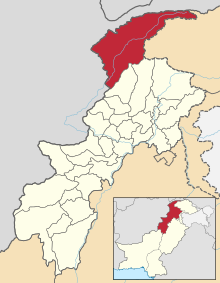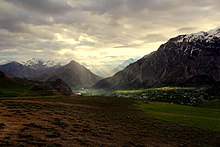| Chitral Districtݯھیترارو ضلع ضلع چترال | |||||||||||
|---|---|---|---|---|---|---|---|---|---|---|---|
| District of Pakistan | |||||||||||
| 1947–2018 | |||||||||||
 Map of the former district in Khyber Pakhtunkhwa | |||||||||||
| Capital | Chitral City | ||||||||||
| Demonym | Chitralis | ||||||||||
| Area | |||||||||||
| • 1947–2018 | 14,850 km (5,730 sq mi) | ||||||||||
| Population | |||||||||||
| • 1947–2018 | 414,000 | ||||||||||
| • Type | District Government | ||||||||||
| History | |||||||||||
| • Established | 14 August 1947 | ||||||||||
| • Establishment of Lower and Upper Chitral | 20 July 2018 | ||||||||||
| Political subdivisions | 6 Tehsils | ||||||||||
| |||||||||||
| Today part of | Pakistan · Lower Chitral & Upper Chitral Districts of Khyber Pakhtunkhwa | ||||||||||
Chitral District (Khowar: ݯھیترارو ضلع; Urdu: ضلع چترال) was a district in the Malakand Division of the Pakistani province of Khyber Pakhtunkhwa, from 14 August 1947 to 2018. It was the largest district in the Khyber-Pakhtunkhwa, covering an area of 14,850 km, before splitting into Upper and Lower Chitral Districts in 2018. It was the northernmost district of Khyber Pakhtunkhwa. It shared a border with Gilgit-Baltistan to the east and with Swat and Dir districts of Khyber Pakhtunkhwa to the south. It also shared an international border with Afghanistan to the north and west. Afghanistan's narrow strip of Wakhan Corridor separated Chitral from Tajikistan in the north.
History
Further information: Chitral (princely state)Chitral shares much of its history and culture with the neighbouring Hindu Kush territories of Gilgit-Baltistan, a region sometimes called "Peristan" because of the common belief in fairies (peri) inhabiting the high mountains.
The entire region that now forms the Chitral District was an independent monarchical state until 1895, when the British negotiated a treaty with its hereditary ruler, the Mehtar, under which Chitral became a semi-autonomous princely state within the Indian Empire. Chitral retained this status even after its accession to Pakistan in 1947, finally being made an administrative district of Pakistan on 14 August 1947, disestablishing the Princely State.
Topography and access

Chitral is counted amongst the highest regions of the world, sweeping from 1,094 metres at Arandu to 7,726 metres at Tirichmir and packing over 40 peaks more than 6,100 metres in height. The terrain of Chitral is very mountainous, and Tirich Mir (25,289 feet), the highest peak of the Hindu Kush, rises in the north of the district. Around 4.8 percent of the land is covered by forest, and 76 percent is mountains and glaciers.
Chitral is connected to the rest of Pakistan by two major road routes, the Lowari Pass ( elevation. 10,23 ft.) from Dir and Shandur Top (elevation 12,200 ft.) from Gilgit. Both routes used to be closed in winter, but circa 2017 the highway Lowari Tunnel under the Lowari Pass opened to vehicular traffic for at least ten hours per day. A number of other high passes, including Darkot Pass, Thoi Pass, and Zagaran Pass, provide access on foot to Chitral from Gilgit-Baltistan.
- Arandu Pass, on the border between Pakistan and Afghanistan
- Broghol Pass, on the border between Pakistan and Afghanistan
- Dorah Pass, on the border between Pakistan and Afghanistan
- Darkot Pass, on the border between Chitral and Gupis-Yasin District
- Shandur Pass, on the border between Chitral and Gilgit-Baltistan
- Lowari Pass, on the border between Chitral and upper Dir
- Lowari Tunnel, highway under Lowari Pass
- Thoi Pass, on the border between Chitral and Gilgit-Baltistan
- Zagaran Pass, on the border between Chitral and Gilgit-Baltistan
Demographics
The district has a population of about 414,000. The general population is mainly made up of Kho people, who speak Khowar, which is also spoken in parts of Yasin, Gilgit, Dir, and Swat. Chitral is also home to the Kalash tribe, who live in Bumburet and two other remote valleys southwest of Chitral town. A few thousand Nuristani people are also known to live in Chitral.
The main language of the region is Khowar. There are also smaller communities of speakers of Arabic, Dameli, Gawar-Bati, Gujari(Gojri), Kalasha, Kyrgyz, Kataviri/Kamviri, Madaklashti, Palula, Sariquli, Wakhi, and Yidgha. Urdu has official status.
Chitral City
The city of Chitral is the main city in the district and serves as its capital. It is situated on the west bank of the Chitral River (also known as the Kunar River) at the foot of Tirich Mir, which at 7,708 m (25,289 ft) is the highest peak of the Hindu Kush. Until 14 August 1947, it served as the capital of the princely state of Chitral.
Administration
The district of Chitral is divided into twenty-four union councils and two tehsils:
National Assembly
This district is represented by one elected MNA (Member of the National Assembly) in Pakistan National Assembly. Its constituency is NA-1.
| Member of National Assembly | Party Affiliation | Year |
|---|---|---|
| Abdul Akbar Khan | Muttahida Majlis-e-Amal | 2002 |
| Shahzada Mohiuddin | Pakistan Muslim League | 2008 |
| Shahzada Iftikhar Uddin | All Pakistan Muslim League | 2013 |
Provincial Assembly
The district is represented by two elected MPAs in the provincial assembly, who represent the following constituencies:
Villages
See also
References
- "Upper Chitral gets status of separate district". Dawn newspaper. 21 November 2018. Retrieved 4 November 2023.
- ^ "District Government Chitral". Chitral District Government Web Portl. Archived from the original on 28 September 2015.
- "Governance and Militancy in Afghanistan and Pakistan". Center for Strategic and International Studies (CSIS).
- Nusser, Marcus; Dickoré, Wolf Bernhard (2002). "A Tangle in the Triangle: Vegetation Map of the Eastern Hindukush (Chitral, Northern Pakistan)" (PDF). Erdkunde. 56 (1): 37–59. doi:10.3112/erdkunde.2002.01.03. JSTOR 23218603.
- Marsden, Magnus (2010). "A tour not so grand: mobile Muslims in northern Pakistan". In Osella; Filippo; Soares; Benjamin (eds.). Islam, Politics, Anthropology. Chichester, England: Royal Anthropological Institute by Wiley-Blackwell. pp. 57–75, page 58. ISBN 978-1-4443-3295-7.
- "Disaster Vulnerability Assessment Report, District Chitral, KPK, Pakistan" (PDF). Hope87.org website. Archived from the original (PDF) on 13 November 2013. Retrieved 4 November 2023.
- ^ Zahiruddin (30 September 2018). "Lowari tunnel: opportunities and challenges". Dawn. Retrieved 26 November 2019.
- "About [Lower Chitral]". Retrieved 16 June 2022.
- "Tehsils & Unions in the District of Chitral". National Reconstruction Bureau, Government of Pakistan website. Archived from the original on 26 March 2012. Retrieved 4 November 2023.
- "Pakistan: North West Frontier Province: District, Tehsil and Union Code Reference Map (MA518-pak-NWFP UCs A3-v01)" (PDF). Pakistan: United Nations Office for the Coordination of Humanitarian Affairs (OCHA). 1 July 2009. Archived from the original (PDF) on 13 November 2013.
- "List of Tehsils/Talukas with Respect to Their Districts". Statistics Division, Ministry of Economic Affairs and Statistics, Government of Pakistan. Archived from the original on 5 March 2010.
- "Election Commission of Pakistan". Archived from the original on 10 November 2015. Retrieved 6 November 2015.
- "Rom Kili: Pakistan". geographic.org. Photius Coutsoukis and Information Technology Associates. Retrieved 29 July 2023.
External links
| Places adjacent to Chitral District | ||||||||||||||||
|---|---|---|---|---|---|---|---|---|---|---|---|---|---|---|---|---|
| ||||||||||||||||
| Pakistan articles | |||||||||||||||||||
|---|---|---|---|---|---|---|---|---|---|---|---|---|---|---|---|---|---|---|---|
| |||||||||||||||||||
| |||||||||||||||||||
| |||||||||||||||||||
| |||||||||||||||||||
| |||||||||||||||||||
| Districts of Khyber Pakhtunkhwa | ||
|---|---|---|
| Provincial capital: Peshawar | ||
| Bannu |  | |
| Dera Ismail Khan | ||
| Hazara | ||
| Kohat | ||
| Malakand | ||
| Mardan | ||
| Peshawar | ||
| Former | ||
36°15′N 72°15′E / 36.250°N 72.250°E / 36.250; 72.250
Categories: